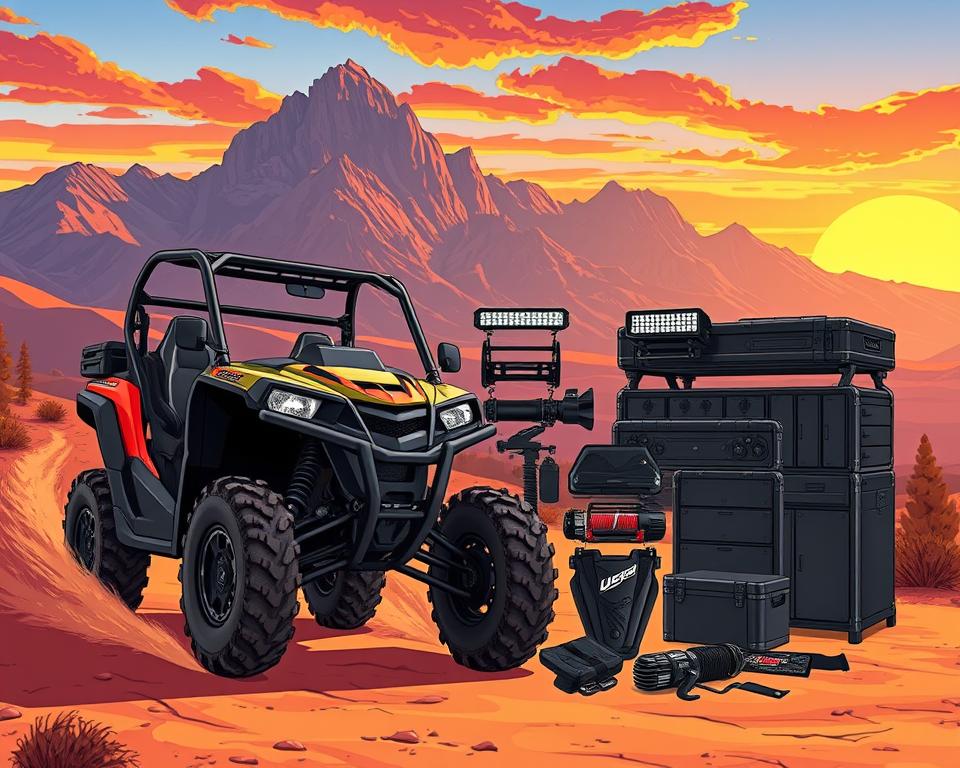Avoiding ATV/UTV Gearing Mistakes for Newbies
It might surprise you to discover that nearly 40% of new ATV and UTV owners face gear selection issues within their first year? This statistic underlines the importance of grasping ATV gear ratios for beginners. Correct gear choice protects against accidents as well as enhances power. In this guide, we cover typical errors, upkeep tips, and pro EFX Motohavok recommendations for better trail experiences.
Essential Insights

- Mastering gear ratios unlocks top performance.
- Typical gear mistakes compromise safety on uneven ground.
- Regular maintenance is key to preventing UTV transmission issues.
- Proper gear selection greatly enhances off-road riding experiences.
- Implementing ATV maintenance tips can prolong vehicle lifespan.
Understanding ATV and UTV Gear Ratios
Gear ratios are vital for the performance of ATVs and UTVs. They shape acceleration and pulling strength. This affects acceleration and the vehicle’s ability to pull loads. Custom gearing shifts focus from speed to torque or vice versa.
Choosing the right UTV gear is key to understanding engine performance. Too low a ratio may leave you underpowered on inclines. Conversely, too high a ratio hampers quick takeoffs on flats.
Riders often tweak reduction ratios for trail versatility. Tuning ratios lets you fine-tune speed vs. torque. It lets you balance acceleration with pulling force. Optimal ratios deliver smoother use and better MPG.
Common Gearing Oversights for New ATV/UTV Owners
Proper gear choice underpins both power and protection. First-timers frequently ignore ratio considerations. Knowing what happens when you misgear and how to fix it transforms your experience. Plus, it prevents mechanical setbacks.
Impact of Incorrect Gear Selection
Wrong ratios threaten stability and component life. The wrong gear can slow down acceleration, affect braking, and cause excessive wear. Such errors endanger everyone, from driver to bystanders. Adhering to service guidelines prevents such failures.
Choosing the Right Gear for Terrain
Trail type dictates ideal gearing. For steep hills, lower gears provide better torque and control. Flats call for taller ratios to boost top-end. Mucky surfaces require cautious gearing to maintain momentum. Knowing these environmental factors is critical for safe and enjoyable off-road adventures.
The Importance of Proper ATV Maintenance
Regular maintenance is key to keeping ATVs and UTVs running smoothly. Using upkeep best practices stops breakdowns and protects riders. A well-planned maintenance schedule focuses on the gear system’s health.
Regular Inspection and Maintenance
A thorough inspection list catches troubles before they grow. Routinely examine gearbox teeth, brake pads, rubber, and belts. Routine checks lead to peak performance. Here are some critical inspection points to remember:
- Examine gear alignment and wear.
- Check for loose bolts or connections.
- Inspect brake lines and levels.
- Verify tire PSI and rubber life.
- Check wiring and connectors for rust.
Fluid Changes and Gear Health
Clean fluids keep transmissions and differentials happy. Frequent changes clear out contaminants. Fresh oil cuts wear and heat for lasting components. Using this method secures dependable function and fewer breakdowns.
| Fluid Type | Recommended Change Interval | Benefits of Regular Change |
|---|---|---|
| Motor Oil | Every 50-100 hours | Cuts friction and boosts power |
| Gear Oil | Every 100-200 hours | Improves shifting, minimizes gear damage |
| Coolant | Annually | Prevents overheating, maintains optimal temperature |
Adhering to this schedule grants worry-free adventures. It turns rides into stress-free experiences.
Common ATV Gear Shifting Problems
New ATV riders often face challenges with gear shifting. Developing fluid shift skills elevates trail enjoyment. You avoid jerky starts and stops. Timing throttle and clutch releases prevents gears from crunching.
Learning to Shift Smoothly
Building graceful shift habits demands consistent effort. Start by getting to know your ATV engine’s rhythm. Careful engagement protects internals and stops wear. Timing your throttle input when releasing the clutch is critical.
Practice shifting in a controlled setting until you’re confident. Apply minimal throttle for smooth transitions.
Recognizing Signs of Gear Issues
Early detection of gear issues is essential. Be alert for clicks, clunks, or grinds when shifting. Difficulty shifting can also signal problems that need quick attention. Addressing issues promptly protects components and riders. Correcting misgears sustains reliability and your enjoyment.
Understanding UTV Transmission Issues
Dealing with UTV transmission problems can be tough, but knowing the common issues is vital for troubleshooting. Owners often face issues like slipping gears or odd noises. Here we examine usual faults and outline a step-by-step fix plan. Drawing on proven UTV repair protocols.
Diagnosing Common Problems
Noticing early clues saves you from expensive repairs. Common issues include:
- Gears that pop out under load, risking accidents.
- Unusual sounds, such as grinding or whining, indicating mechanical damage.
- Drips or puddles under the UTV may foretell failures.
Routine checks uncover faults early. You can then address issues swiftly. Missing early clues damages your ride and wallet.
Solutions for Troubleshooting UTV Transmissions
Repairing gearbox problems calls for methodical steps. Follow these steps for effective troubleshooting:
- Check fluid levels and top up if necessary.
- Look for wet spots beneath the transmission.
- Assess internal components for wear or chipping.
- Operate the UTV under different loads to observe shift quality.
- Reference factory troubleshooting charts for your UTV.
Using a reliable UTV troubleshooting guide can streamline the process. Knowing how transmissions work benefits every rider. It greatly enhances your vehicle’s longevity and efficiency.
ATV Clutch Adjustments and Their Benefits
Accurate clutch tuning unlocks seamless shifts. Incorrect adjustments can make shifting gears tough, frustrating for beginners. Routine calibration refines clutch response and engagement.
Adjusting gears with precision is vital. A well-set clutch delivers fast, clean shifts. It refines acceleration and comfort across all conditions.
Neglecting clutch upkeep accelerates wear and reduces power. Proper maintenance leads to smoother shifts and better engine response. Every operator should prioritize clutch checks for optimal use.
Mastering the Art of Gear Shifting
Excelling at transitions elevates your trail adventures. You need mechanical insight and precise timing to nail each shift. Beginners should focus on the rhythm of shifting gears. A comfortable cadence leads to smoother transitions and improved performance.
Skillful shifting comes from drilling in diverse environments. Understanding when to shift gears based on terrain type enhances control and safety. Downshifting into grades safeguards momentum and balance.
- Rehearse clicks slowly to gain control.
- Observe how your vehicle responds to different shifts.
- Step up to steeper, rougher trails as you improve.
Getting in sync with your ride ensures perfect shifts. Heed revs and shakes to know shift points. Such feedback tells you when to execute transitions. That instinctive skill yields seamless shifts and more fun.
Best Practices for UTV Gear Selector Problems
Tackling selector issues calls for scheduled checks and troubleshooting. Frequent selector checks prevent surprises. Learning proper lever use minimizes failures. Check shifter arms and oil levels with each maintenance session.
When facing gear selector issues, first check the selector mechanism for obstructions or damage. Unusual noises can also hint at problems. Minor tweaks typically fix selector snags. A routine plan stops small faults from growing.
Logging selector behavior in varied rides highlights issues. Following these methods preserves selector health and rider trust.
Tips for Enhancing Gear Performance
Sustaining peak gear health involves systematic care. Regular maintenance is key to improving ATV efficiency. It’s important to check fluid levels, inspect for wear, and adjust settings as needed. Catching nicks before they worsen saves you big bucks.
Selecting proper reductions yields prompt acceleration and fluid movement. Understanding the terrain you will face allows you to select the appropriate ratios. This decision impacts everything from acceleration to top speed. Partnering with trusted makers like American Off-Roads for UTV performance enhancements adds power and reliability.
Implementing gear performance tips in wheels, springs, and ballast optimization elevates function. These tweaks guarantee superior handling in rough conditions. You’ll notice more thrill and less stress on every trip. Implementing these strategies will allow riders to navigate with confidence while enjoying the thrill of the ride.
As a Final Point
Nailing gear selection unlocks peak power and protection. Matching gears to ground types transforms your adventure. By avoiding common mistakes and making smart choices, your off-road trips will be both fun and secure.
The importance of performance maintenance cannot be overstated. Scheduled maintenance and TLC save you from breakdowns and prolong service. Adequate maintenance enhances function and safeguards adventures across any terrain.
Understanding gear selection and prioritizing maintenance leads to a more fulfilling experience for ATV/UTV fans. Following these guidelines paves the way for endless trail excitement.
Frequently Asked Questions
What are the typical gear ratios for ATVs and UTVs?
ATVs and UTVs have gear ratios that vary widely, depending on the model. Most fall between about 3:1 and 5:1. Low-end ratios yield higher pulling power. Higher ratios, on the other hand, can increase top speed on flat terrain.
Signs of misgearing for different surfaces?
Misgearing risks unstable handling, rev overload, or sluggish starts. Different grounds need dedicated ratios to maintain traction and speed.
Warning signs for upkeep on your off-road vehicle?
Pay attention to hard shifts, strange sounds, leaky fluid, or waning torque. Scheduling drivetrain inspections stops big failures.
When to swap your drivetrain oils?
Rotate your oils at 1.5–2.5K miles or yearly, based on how and where you ride. Pure oils maintain smooth shifts and protect internals over time.
Best practices for flawless shifts?
For smooth gear shifting, practice coordinating the throttle and clutch. Gradually release the clutch while pressing the throttle to match engine speed with wheel speed.
How can I troubleshoot UTV transmission issues?
Begin with fluid level checks and a listen for whines or grinds. Inspect the transmission fluid level and condition. Next, test-drive at varied speeds to see how it shifts.
Why adjust your ATV clutch?
Fine-tuned clutches deliver flawless shifts. An improperly set clutch can cause shifting difficulties and may lead to premature wear on transmission components.
Optimizing gears for varied ground?
Test multiple gearing options and look into quality mods by American Off-Roads. Scheduled service—linkage grease and oil changes—maintains top output.
Addressing a bad gear selector?
Regular inspections and routine maintenance are key. When the shifter binds, use the OEM troubleshooting procedures to find the root cause.
Beginner pitfalls in gear selection?
New owners often overlook the importance of understanding gear ratios, neglect routine maintenance, or fail to adjust gears according to terrain. These mistakes hamper performance and raise the chance of mishaps.
